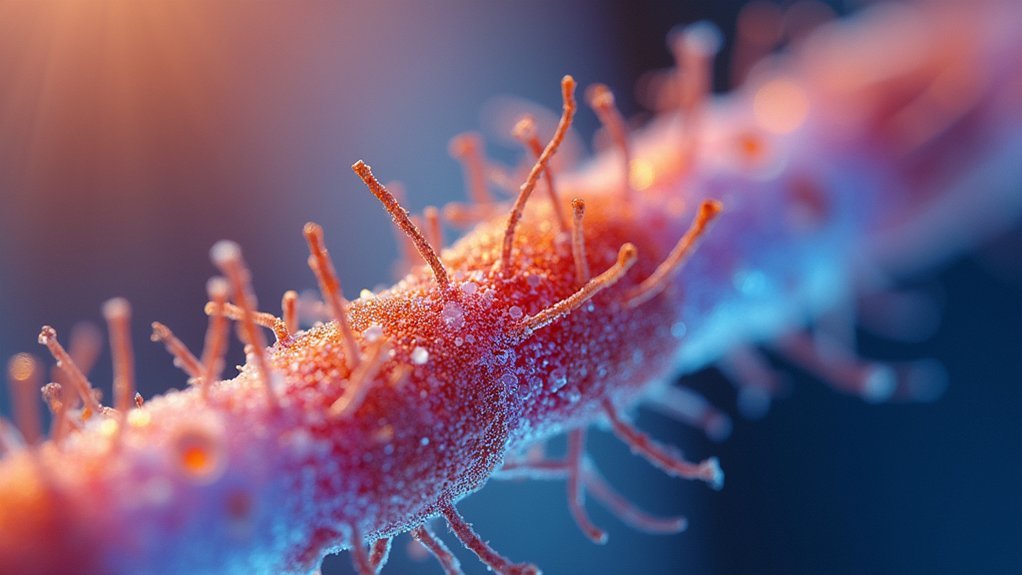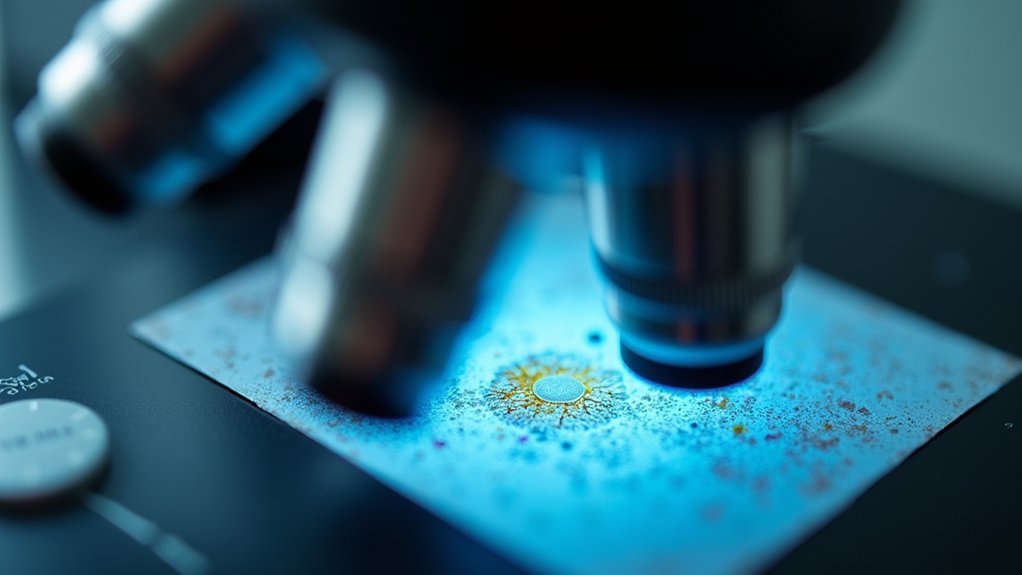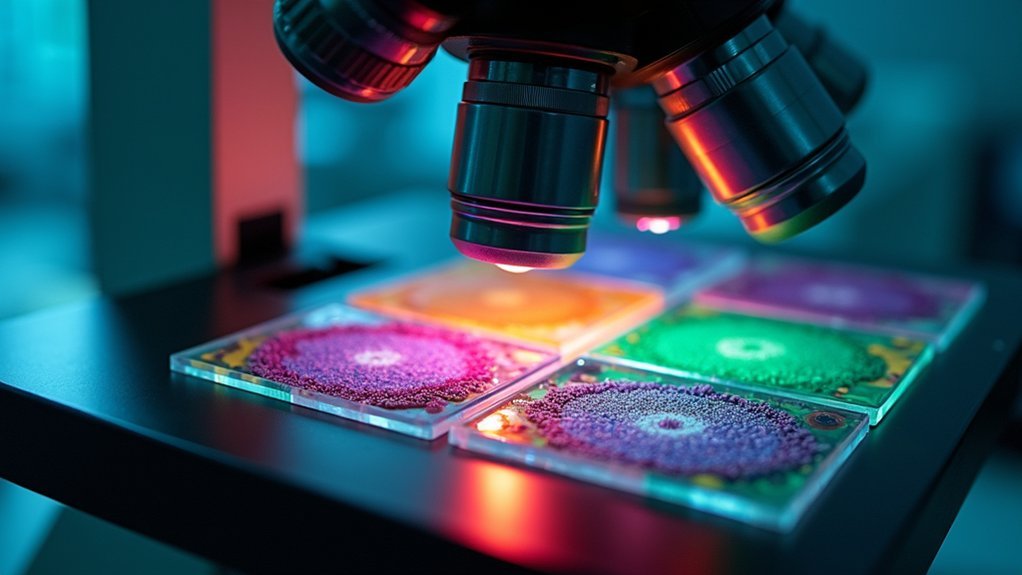For microscope photography, you’ll get the best image quality using low ISO settings (50-100), which maximize detail capture and minimize noise. Use longer exposure times rather than higher ISO when possible. For moving specimens or low light conditions, increase to ISO 200-400, but avoid exceeding ISO 800 to prevent significant quality degradation. Dedicated microscope cameras offer superior performance at low ISO settings compared to mobile devices. Different specimen types require specific ISO adjustments for ideal visualization.
7 Second-Level Headings

When capturing microscope photos, your ISO setting fundamentally determines image quality and detail retention. For ideal results, you’ll want to select a low ISO, typically between 50 and 100, as this maximizes dynamic range and preserves fine details in your microscope images.
Your digital camera performs best at these lower ISO values, capturing more color information and brightness levels without introducing noise that can obscure essential specimen features.
While adjusting exposure settings, remember that specimens are stationary, allowing you to compensate for low ISO with longer exposure times rather than increasing sensitivity.
Even in challenging lighting conditions, prioritize maintaining low ISO and instead adjust illumination sources. This approach guarantees your microscope images retain the clarity and contrast necessary to distinguish subtle structures and characteristics within your specimens.
Understanding ISO Settings in Microscope Photography
Although many photographers focus primarily on magnification and lighting, ISO settings play an essential role in microscope photography that’s often overlooked.
When capturing microscopic specimens, you’ll achieve superior results by selecting low manual ISO settings, typically 50 or 100.
These lower ISO values considerably enhance your image quality by improving dynamic range and reducing noise. You’ll notice greater clarity in fine details and better contrast between subtle features of your specimens.
Low ISO settings provide exceptional clarity and contrast, revealing the finest details in your microscopic specimens.
Lower settings also capture light intensity more accurately, resulting in better color representation and brightness levels.
An additional benefit is the flexibility with exposure times. You can use longer exposures without introducing unwanted noise, which helps when working with challenging specimens.
For ideal microscope photography, prioritize these low ISO settings to capture the intricate details your research requires.
The Benefits of Low ISO Settings for Specimen Detail Capture

Low ISO settings represent the foundation of exceptional microscope photography by maximizing your sensor’s inherent capabilities.
When you select ISO values like 50 or 100, you’ll achieve greater dynamic range, allowing your microscope images to display more subtle gradations in brightness and color intensity.
- Enhanced image quality – Lower ISO settings improve contrast, making fine details in specimens more distinguishable for accurate analysis.
- Vibrant images with better color reproduction – You’ll capture a wider spectrum of colors and brightness levels, resulting in more lifelike specimen representation.
- Flexible exposure times – Low ISO enables longer exposures without introducing noise, perfect for static specimens where you need maximum clarity.
When Higher ISO Settings Become Necessary in Microscopy
While low ISO values are ideal for most microscopy work, you’ll need to increase your ISO when facing challenging lighting conditions with dim or minimal illumination.
Higher ISO settings become essential when you’re capturing rapidly moving specimens like living microorganisms that require faster shutter speeds to prevent blur.
You’ll find this trade-off necessary in situations where specimen preservation is paramount, as higher ISO allows you to reduce both exposure time and light intensity that might damage delicate samples.
Challenging Lighting Conditions
Despite best efforts to optimize your microscope’s illumination, you’ll inevitably encounter situations where light becomes scarce. In these low light situations, you’ll need to adjust your ISO settings upward—typically between 400-1600—to capture adequate exposure while minimizing noise.
Higher ISO settings allow for shorter exposure times, which becomes critical when working at high magnifications where even slight movements can blur your image.
When facing challenging lighting conditions, remember:
- Balance is key—increase ISO just enough to achieve proper exposure without compromising image quality
- Transparent or colorless specimens often benefit from higher ISO to reveal subtle details
- Use a stabilized setup when employing elevated ISO levels to counteract longer exposure times
Your choice of ISO should ultimately reflect both your specimen’s characteristics and available lighting conditions.
Rapid Movement Capture
Living specimens under your microscope rarely cooperate by staying still, making rapid movement capture one of the most challenging aspects of microscopy photography. When dealing with active microorganisms, you’ll need to increase your ISO settings to 400 or higher to effectively freeze motion and prevent motion blur.
Higher ISO values markedly reduce exposure times, allowing for quicker shutter releases essential when documenting dynamic samples. While you might worry about noise, modern cameras with high light sensitivity can still deliver quality images in low light conditions.
Balance is vital—excessively high ISO settings will introduce graininess and reduce dynamic range.
For ideal results when shooting at higher ISO values, consider implementing image stacking techniques. This approach helps mitigate noise while enhancing image clarity, preserving important details in your rapidly moving specimens.
Balancing ISO With Other Camera Settings for Optimal Results

Achieving exceptional microscope photography requires careful coordination between ISO and other camera settings. When you pair low ISO settings (50-100) with appropriate aperture and shutter speed adjustments, you’ll capture microscopic details with remarkable clarity.
These settings work together as a system to maximize both exposure and image sharpness.
- Aperture balance – Select a wider aperture to allow more light when using low ISO settings, compensating for reduced sensitivity while maintaining detail.
- Shutter timing – Adjust your shutter speed in relation to your ISO to prevent motion blur while ensuring proper exposure.
- Lighting technique – Implement consistent, stabilized lighting to complement your low ISO, reducing the need for sensitivity adjustments that might introduce noise.
ISO Performance Differences Across Camera Types for Microscopy
Different camera types exhibit distinct ISO performance characteristics that directly impact your microscopy results.
DSLRs and mirrorless cameras typically offer superior low-light capabilities and noise control at varying ISO settings compared to the inherent limitations of mobile phone cameras.
Dedicated microscope cameras, while purpose-built with optimized sensors for scientific imaging, often provide specialized ISO performance tailored specifically for microscopy applications.
DSLR Vs Mirrorless ISO
When choosing between DSLR and mirrorless cameras for microscopy, understanding their ISO performance differences can greatly impact your results.
DSLRs typically show more noticeable noise at higher ISO settings compared to their mirrorless counterparts, which leverage advanced sensor technology for cleaner images.
For ideal microscopy photography, consider these critical differences:
- Low ISO advantage – Both camera types perform best at ISO 50-100, but mirrorless cameras often maintain better image quality with less noise when you need to increase sensitivity.
- Dynamic range capability – Mirrorless models can achieve up to 15 f-stops of dynamic range, preserving more detail in both highlights and shadows.
- Extreme sensitivity potential – Full-frame mirrorless cameras can reach ISO 400,000+, offering superior performance in challenging microscopy lighting conditions.
Mobile Camera Limitations
Although mobile cameras have revolutionized accessibility to microscopy photography, they face significant ISO performance limitations that directly impact image quality.
Your smartphone typically can’t achieve the low ISO settings (50-100) that dedicated cameras offer, with many starting at ISO 200 or 400.
This higher base ISO creates a fundamental disadvantage when capturing microscopic specimens, especially in low light conditions. You’ll notice increased noise and reduced dynamic range compared to DSLR or mirrorless systems.
The smaller sensors in mobile devices simply can’t gather light as efficiently.
While premium smartphones have improved their capabilities, they still lack the manual ISO controls and extensive dynamic range that microscopy often demands.
If you’re serious about microscope photography, you’ll need to work around these mobile camera limitations or consider a dedicated system.
Dedicated Microscope Cameras
Unlike mobile options, dedicated microscope cameras offer considerable advantages in ISO performance that directly translate to superior image quality. These specialized devices excel at lower ISO settings (50-100), capturing specimens with remarkable clarity and high dynamic range of up to 15 f-stops.
- Full-frame sensors (36 x 24 mm) considerably enhance your color accuracy and detail preservation at low ISO settings, allowing you to discern subtle variations in specimen structure.
- Impressive sensitivity ratings reaching ISO 400,000+ give you flexibility across different lighting conditions without sacrificing quality.
- Advanced features like remote control capabilities and image stacking further optimize your microscopy photography, especially when working at low ISO settings.
For professional microscopy work, these dedicated cameras deliver the precision and performance that simply can’t be matched by consumer alternatives.
Practical ISO Recommendations for Common Specimen Types
Selecting the right ISO setting for your microscope photography depends largely on the specimen you’re examining and the illumination technique you’re using.
For bright specimens under standard conditions, start with ISO 100 to capture high-quality images with minimal noise and excellent detail.
When working with low-contrast specimens that are more transparent, try increasing to ISO 200-400 to enhance visibility while maintaining image clarity. This slight adjustment can make subtle details more apparent without introducing significant noise.
For dark-field microscopy or fluorescence techniques where lighting conditions are inherently dimmer, ISO settings of 400-800 are appropriate to compensate for reduced illumination.
However, avoid exceeding ISO 800 whenever possible, as higher values introduce noise that degrades detail and compromises your results.
Frequently Asked Questions
What Camera Settings Are Needed for Microscope Photography?
For microscope photography, you’ll need manual exposure settings. Use low ISO (50-100), adjust shutter speed based on lighting, guarantee proper stabilization, and control aperture for depth of field and focus clarity.
What ISO Setting Gives the Best Image Quality?
For best image quality, you’ll want to use the lowest ISO setting possible, typically 50-100. This minimizes noise, maximizes dynamic range, and preserves fine details in your photos.
How to Get Good Microscope Photos?
Use low ISO (50-100), attach a manual camera with an adapter, optimize LED lighting, employ precise focusing techniques, and try post-processing tools like stacking software. You’ll get crisp, detailed microscope images with these steps.
How to Get a Clear Image on a Microscope?
To get a clear microscope image, use low ISO (50-100), adjust focus carefully with both coarse and fine knobs, guarantee proper lighting, stabilize your setup, and consider focus stacking for improved depth of field.
In Summary
You’ll find that lower ISO settings (100-400) generally work best for microscope photography, giving you crisp, noise-free images of well-lit specimens. When light is limited, don’t hesitate to increase ISO, but balance it carefully with aperture and shutter speed. Remember that your camera’s sensor quality greatly affects high-ISO performance, so experiment with your specific setup to discover the ideal settings for your unique specimens.





Leave a Reply